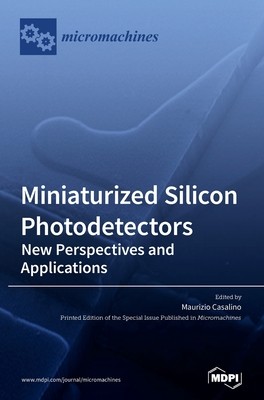
- We will send in 10–14 business days.
- Publisher: MDPI AG
- ISBN-10: 3036500448
- ISBN-13: 9783036500447
- Format: 17 x 24.4 x 1.4 cm, kieti viršeliai
- Language: English
- SAVE -10% with code: EXTRA
Miniaturized Silicon Photodetectors (e-book) (used book) | bookbook.eu
Reviews
Description
Silicon (Si) technologies provide an excellent platform for the design of microsystems where photonic and microelectronic functionalities are monolithically integrated on the same substrate. In recent years, a variety of passive and active Si photonic devices have been developed, and among them, photodetectors have attracted particular interest from the scientific community. Si photodiodes are typically designed to operate at visible wavelengths, but, unfortunately, their employment in the infrared (IR) range is limited due to the neglectable Si absorption over 1100 nm, even though the use of germanium (Ge) grown on Si has historically allowed operations to be extended up to 1550 nm. In recent years, significant progress has been achieved both by improving the performance of Si-based photodetectors in the visible range and by extending their operation to infrared wavelengths. Near-infrared (NIR) SiGe photodetectors have been demonstrated to have a "zero change" CMOS process flow, while the investigation of new effects and structures has shown that an all-Si approach could be a viable option to construct devices comparable with Ge technology. In addition, the capability to integrate new emerging 2D and 3D materials with Si, together with the capability of manufacturing devices at the nanometric scale, has led to the development of new device families with unexpected performance. Accordingly, this Special Issue of Micromachines seeks to showcase research papers, short communications, and review articles that show the most recent advances in the field of silicon photodetectors and their respective applications.
EXTRA 10 % discount with code: EXTRA
The promotion ends in 23d.04:11:07
The discount code is valid when purchasing from 10 €. Discounts do not stack.
- Publisher: MDPI AG
- ISBN-10: 3036500448
- ISBN-13: 9783036500447
- Format: 17 x 24.4 x 1.4 cm, kieti viršeliai
- Language: English English
Silicon (Si) technologies provide an excellent platform for the design of microsystems where photonic and microelectronic functionalities are monolithically integrated on the same substrate. In recent years, a variety of passive and active Si photonic devices have been developed, and among them, photodetectors have attracted particular interest from the scientific community. Si photodiodes are typically designed to operate at visible wavelengths, but, unfortunately, their employment in the infrared (IR) range is limited due to the neglectable Si absorption over 1100 nm, even though the use of germanium (Ge) grown on Si has historically allowed operations to be extended up to 1550 nm. In recent years, significant progress has been achieved both by improving the performance of Si-based photodetectors in the visible range and by extending their operation to infrared wavelengths. Near-infrared (NIR) SiGe photodetectors have been demonstrated to have a "zero change" CMOS process flow, while the investigation of new effects and structures has shown that an all-Si approach could be a viable option to construct devices comparable with Ge technology. In addition, the capability to integrate new emerging 2D and 3D materials with Si, together with the capability of manufacturing devices at the nanometric scale, has led to the development of new device families with unexpected performance. Accordingly, this Special Issue of Micromachines seeks to showcase research papers, short communications, and review articles that show the most recent advances in the field of silicon photodetectors and their respective applications.


Reviews